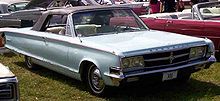Chrysler 300 non-letter series
The Chrysler 300 Sport (without letter designation) was introduced by Chrysler in 1962 as the successor to the Windsor model and offered until 1971.
year for year
Model year 1962 (Series SC2-M)
The car corresponded in its appearance to the model 300H of the Chrysler 300 letter series . Only the "H" on the hubcaps and trunk was missing. In addition to a - rarely ordered - 4-door sedan, two hardtop models with 2 or 4 doors (the most frequently ordered models in the series) and a 2-door convertible were offered. Instead of the 6.7-liter V8 engine, the vehicles had a V8 with a displacement of 6,276 cc that delivered 305 bhp (224 kW) at 4,600 rpm.
Model year 1963 (TC2-M series)
In 1963 the series was expanded, with the body being adapted to the 300J model of the "Letter Series". This year, a convertible of this type was the official pace car for the Indy 500 race.
Model year 1964 (Series VC2-M)
In 1964 the name "Sport" was dropped and the body was adapted to the 300K model of the "Letter Series". The normal 300 could be distinguished from this by a silver stripe on the side.
Model year 1965 (series AC2-M)
In 1965, the 300 and the new 300L received completely new bodies. Again, both series differed from the outside only by the letter "L", which the "Letter Car" carried in the radiator grille and on the hubcaps. The engine of the 300 was 10 bhp more powerful with the same displacement and delivered 315 bhp (232 kW) at 4,400 rpm.
Model year 1966 (series BC2-M)
In 1966 the engine output increased again to 325 bhp (239 kW). The body changes were rather minor. 47,245 Chrysler 300s were manufactured, plus 2,353 four-door sedans for export to Canada.
Model year 1967 (Series CC2-M)
In 1967 came a new body. It looked more elongated and flatter than the previous models. The 6.3-liter V8 was taken out of the range, as was the sedan exported to Canada. Instead, the vehicles were equipped with the New Yorker's 7,221 cm³ engine with 350 bhp (257 kW) . What remained was a four-door model with a coupé-like appearance, the coupé and the convertible. 21,894 vehicles were produced.
Model year 1968 (series DC2-M)
In 1968 the changes were only a few optical details. Technically everything stayed the same and 34,621 units left the production line.
Model year 1969 (series EC-M)
The 1969 model has been redesigned. With a large radiator grille extending across the entire width of the vehicle , associations with the then current Chrysler muscle cars were not unintentional. The look was called " fuselage styling " (meaning: aircraft fuselage design) because of the elongated, bulbous shape . 32,472 units were built.
Model year 1970 (FC-M series)
In 1970 hardly anything was changed compared to the previous year. 20,512 Chrysler 300s were produced in 1970. These sales figures could be attributed to the fact that, due to stricter environmental laws and higher insurance premiums in the USA, potential car buyers preferred more economical models. And the Chrysler 300 was still offered exclusively with the 7.2 liter V8. In the middle of the year, the Chrysler 300 Hurst was released, a special limited edition model of which 485 were produced.
Model year 1971 (Series GC-S)
1971 came the end of the Chrysler 300, which had been in continuous production since 1962. The body shapes remained identical to those of the two previous years, only the convertible was finally deleted from the range. Due to the new emissions regulations, the compression ratio of the basic version of the 7.2 liter V8 was reduced, thereby reducing the output to 335 bhp (246 kW). Since the 300 series was about to end anyway, no other changes were made except for the obligatory facelift . 13,939 pieces formed the end.
Web links
source
- John Gunnell (Ed.): Standard Catalog of American Cars 1946-1975 . 4th edition. Krause Publications, Iola 2002, ISBN 0-87349-461-X .



